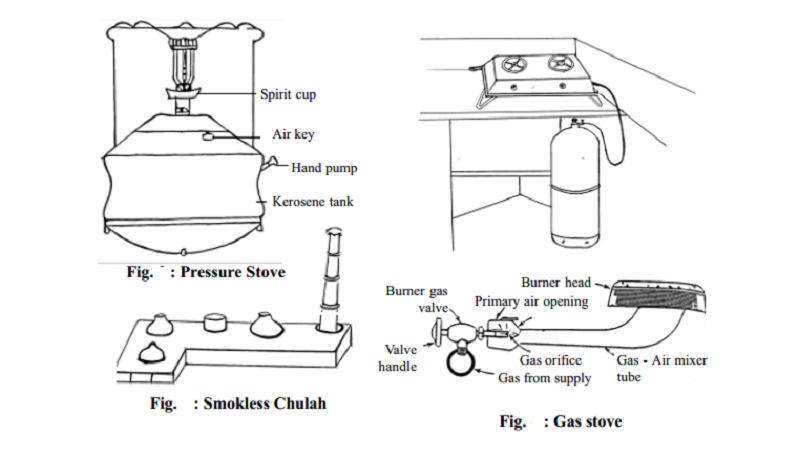Chapter: 11th 12th std standard Home Science Maintain Basic Knowledge for family life Higher secondary school College
Ovens - Various Chulah or Stove

OVENS
1. The traditional Chulah
In India this is the commonest type in most parts, but rather old
fashioned. It stands on three stones holding any type or size of vessel over
it. The fuel burnt in this chulah is usually pieces of wood and twigs. Fire
wood makes a better fuel compared to other fuels such as saw dust, waste paper,
cowdung cake, husk, coconut shells and other organic waste. Proper chimneys
need to be constructed to let out smoke from the kitchen.
2. Smokeless Chulah
The
ordinary traditional chulah was made more efficient and economical by evolving
smokeless chulah. The Hindi word 'chula' means a fire place or stove for
cooking. Some of the smokeless chulahs are magan chulah, gujarat chulah, nada
chulah and Dr. S.P.Raju's chulah. Red clay, cowdung and hay are used to set the
platform. The pot seats are scooped out. There is a passage between the pot
seats, large enough for the flame to pass. The smoke is drawn out through the
chimney. Hence kitchen can be maintained smokeless. Usually there are three pot
seats, at one end the fuel is fed. If any pot seat is not used, it must be
covered to prevent the smoke escaping from it.
3. Charcoal Sigri
A charcoal sigri is made up of iron. The stove is not costly and has the
advantage of producing less smoke. Charcoal is the charred remains of heated
wood. It is black and brittle. It is easy to light and when lit it burns,
intensely glowing red. It needs fanning often to ensure a uniform heating. The
disadvantage of this stove is, if the room is not well ventilated there is the
danger of carbon monoxide poisoning through the fumes of the unconsumed gas
given out from the charcoal.
4. Oil Stove
In the
market, several oil stoves are available for cooking. They are economical,
portable, can be easily lit, and well managed. They are available in various
shapes and sizes. Oil stoves are more extensively used in places where there is
scarcity of electricity and gas.
Clean kerosene oil should be used. The kerosene stove does not burn the
liquid kerosene straight away but only burns the vapour of kerosene which is
produced by heat. The result is a blue flame which gives out intense heat.
Special care is needed to keep them clean and in good order. The odour of
kerosene oil will otherwise make the food unpalatable. Their efficiency depends
upon how regularly wicks are trimmed, oil is fed and the stove is maintained.
Pressure Stove
Pressure Stoves are an improvement over the wick stoves. This appliance
consists of a burner top and a tank at the bottom for the kerosene. The tank is
filled with pump, a lid and an air key. There is a spirit cup at the centre of
the stove and a nipple on top of it. In general pressure stoves consume less of
kerosene and produce a hotter flame than the wick stove.
The
pressure stoves are not easy to keep clean. Pressure stoves need pricking,
priming and pumping before they can be lit. It causes soot on lighting. It is
too hot for simmering purposes. It needs to be pumped up from time to time.
5. Gas Stove
For
domestic use, liquefied petroleum gas is generally supplied in steel cylinders
used in this type of stove. Cooking in gas stoves are efficient, as heat is
easily regulated. It is convenient and economical in the long run. A short
piece of special tubing connects the cylinder carrying the gas. When the
cylinder valve is opened, the evaporated gas pass through the regulator to the
stove. Gas stove saves time and energy for the home makers. Hence, labour
saving. It does not produce soot on the cooking utensil, since there is no
smoke. It helps to maintain the kitchen neat, tidy and clean. It is more
helpful in quantity cookery in hostels and hotels. Leakage of gas should be
prevented.
6. Electric Range
When a current of electricity passes through a conductor, heat is
produced. Electric stoves, are heated by coils through which current passes.
Appliances such as heaters, hotplates, kettles and toaster are coming into
common use. The absence of smoke, smell or ash are the advantages. In India,
due to the high cost of electricity, electrical equipment, scarcity of electricity
and fear of accidents, it is not commonly used.
7. Solar Cookers
The
advancement of modern science has made available many techniques for using the
different potentials of energy and utilizing them for increasing fuel needs.
Many cooking devices utilizing the solar energy have been developed at present.
One such is solar oven that has received considerable attention. The reflector
solar devices have taken many sizes, shapes and materials of construction. The
solar cooker properly designed can deliver temperature as high as 450oc.
In a tropical country like India, the wide use of solar ovens should be
enthusised with proper results to suit urban and rural or high and low income
families.
The solar cookers are used to boil rice and dhal, bake biscuits and
roast groundnut. The solar heaters are used for the provision of hot water for
domestic uses. Solar heated water may be sufficient for bathing, washing and
cooking needs of the family.
Related Topics